Navajoe is a ghost town in Jackson County, Oklahoma, United States, located eight miles east and four miles north of Altus at the base of the Navajo Mountains.
Contents

Navajoe is a ghost town in Jackson County, Oklahoma, United States, located eight miles east and four miles north of Altus at the base of the Navajo Mountains.

According to local lore, the town took its name from the nearby Navajo Mountains, where, in the mid-1800s, Comanches annihilated a band of Navajos who were on a raid to steal Comanche horses. [1] In those times, the Comanches and their close allies, the Kiowas, were constantly in conflict with the Navajos, and such long distance raids across the Texas Panhandle by the warring tribes were not uncommon. Quanah Parker, the renowned Comanche chief, gave a detailed account of an essentially identical failed Navajo raid, in 1848 or 1849, against his village on Elk Creek, just north of the mountains. [2] [3] Given that such raid on Quanah's village occurred at the same time and in the same place with the same results, it was quite likely the raid that gave the mountains their name. [4]
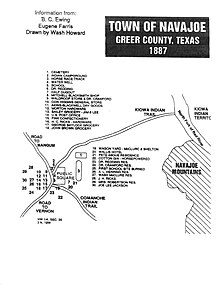
In 1886, when the area was still claimed as Greer County, Texas, W.H. Acers and H. P. Dale opened a general store at the site that was to become Navajoe. The location was intended to take advantage of its proximity to the nearby Western Cattle Trail and the Indian Reservation at Fort Sill. [1] [5] In 1887, the town got its start when "Buckskin Joe" Works, a colorful Texas land promoter made his appearance at a Fourth of July picnic attended by area settlers, cowhands and a contingent of Comanche braves led by Quanah Parker. [5] During the festivities, it was agreed to lay out an eighty-acre town site. Buckskin Joe was to receive one-half of the lots in return for his promotion of the town and adjacent area, which he accomplished through his Texas-Oklahoma Colony, the Emigrant Guide and well publicized excursions for prospective settlers. [5]
Also in 1887, the town received a post office designated as "Navajoe" to avoid confusion with Navajo, Arizona. In that same year, a Baptist church was organized, the first Protestant church in what would become Oklahoma Territory. [6] In 1888, Navajoe School opened. [7] [8]
Soon, more than 200 families had settled in and around Navajoe. The town became a trade center for the area's settlers, cowhands and Indians. In addition to the post office, school and churches, it had grocery stores, hardware stores, saloons, a general store, a blacksmith shop, a confectionery, a dry goods store, a wagon yard, a hotel and a cotton gin. To travel from the reservation to the town, the Kiowas rode around the north side of the mountains over the Kiowa Trail, and the Comanches came around the south side over the Comanche Trail. [1] [7] [8]
A typical frontier town, Navajoe had its share of gunfights and outlaw activity. In 1891, a Kiowa uprising, resulting from the killing of one of their chiefs by a cowhand in an argument over beeves, caused area families to seek refuge in the town and a detachment to be dispatched from Fort Sill. [1] [7] [8]

But, in 1902, the railroad bypassed Navajoe, and most of the businesses moved, buildings and all, to the new town of Headrick on the railroad. In 1920, Navajoe School was consolidated with Friendship and parts of other nearby school districts. [7] [8] Today, all that remains is a picturesque, well kept cemetery, nestled at the foot of the mountains, which is still used for burials today. A granite monument, erected in its center in 1976, displays a map of the old town and pays tribute to its history. [1] [4] [7] [8]
The name of Navajoe, however, lives on. In 1963, the Friendship and Warren school systems joined to build a new school halfway between the two towns. The new school, which graduated its first class in 1964 and still thrives in northeastern Jackson County, was called Navajo—this time without the addition of an "e" to satisfy the postal authorities. [4]
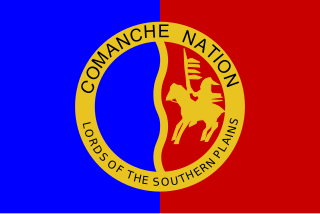
The Comanche or Nʉmʉnʉʉ is a Native American tribe from the Southern Plains of the present-day United States. Comanche people today belong to the federally recognized Comanche Nation, headquartered in Lawton, Oklahoma.
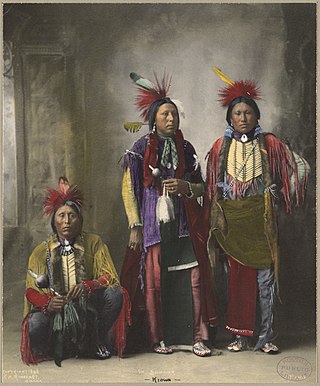
Kiowa or CáuigúIPA:[kɔ́j-gʷú]) people are a Native American tribe and an Indigenous people of the Great Plains of the United States. They migrated southward from western Montana into the Rocky Mountains in Colorado in the 17th and 18th centuries, and eventually into the Southern Plains by the early 19th century. In 1867, the Kiowa were moved to a reservation in southwestern Oklahoma.

The Fort Parker massacre, also known as the Fort Parker raid, was an event in which a group of Texan colonists were killed in an attack by a contingent of Comanche, Kiowa, Caddo, and Wichita raiders at Fort Parker on May 19, 1836. During the attack, Cynthia Ann Parker, then approximately nine years old, was captured and spent most of the rest of her life within the Comanche Nation, later marrying Chief Peta Nocona and giving birth to three children, including a son, Quanah Parker, who became a prominent leader of the Comanches and a war leader during the Red River War of 1874–75. Cynthia’s brother John Richard Parker was also captured and remained with the Comanches for six years before his release was negotiated. He was unable to readapt to Western society and chose to return to the Comanche Nation.

Quanah Parker was a war leader of the Kwahadi ("Antelope") band of the Comanche Nation. He was likely born into the Nokoni ("Wanderers") band of Tabby-nocca and grew up among the Kwahadis, the son of Kwahadi Comanche chief Peta Nocona and Cynthia Ann Parker, an Anglo-American who had been abducted as an eight-year-old child during the Fort Parker massacre in 1836 and assimilated into the Nokoni tribe. Following the apprehension of several Kiowa chiefs in 1871, Quanah Parker emerged as a dominant figure in the Red River War, clashing repeatedly with Colonel Ranald S. Mackenzie. With European-Americans hunting American bison, the Comanches' primary sustenance, into near extinction, Quanah Parker eventually surrendered and peaceably led the Kwahadi to the reservation at Fort Sill, Oklahoma.

Cynthia Ann Parker, Naduah, Narua, or Preloch, was a woman who was captured, aged around nine, by a Comanche band during the Fort Parker massacre in 1836, where several of her relatives were killed. She was taken with several of her family members, including her younger brother John Richard Parker. Parker was later adopted into the tribe and had three children with a chief. Twenty-four years later she was relocated and taken captive by Texas Rangers, aged approximately 33, and unwillingly forced to separate from her sons and conform to European-American society. Her Comanche name means "was found" or "someone found" in English.

The Comanche Wars were a series of armed conflicts fought between Comanche peoples and Spanish, Mexican, and American militaries and civilians in the United States and Mexico from as early as 1706 until at least the mid-1870s. The Comanche were the Native American inhabitants of a large area known as Comancheria, which stretched across much of the southern Great Plains from Colorado and Kansas in the north through Oklahoma, Texas, and eastern New Mexico and into the Mexican state of Chihuahua in the south. For more than 150 years, the Comanche were the dominant native tribe in the region, known as “the Lords of the Southern Plains”, though they also shared parts of Comancheria with the Wichita, Kiowa, and Kiowa Apache and, after 1840, the southern Cheyenne and Arapaho.

The Red River War was a military campaign launched by the United States Army in 1874 to displace the Comanche, Kiowa, Southern Cheyenne, and Arapaho tribes from the Southern Plains, and forcibly relocate the tribes to reservations in Indian Territory. The war had several army columns crisscross the Texas Panhandle in an effort to locate, harass, and capture nomadic Native American bands. Most of the engagements were small skirmishes with few casualties on either side. The war wound down over the last few months of 1874, as fewer and fewer Indian bands had the strength and supplies to remain in the field. Though the last significantly sized group did not surrender until mid-1875, the war marked the end of free-roaming Indian populations on the southern Great Plains.
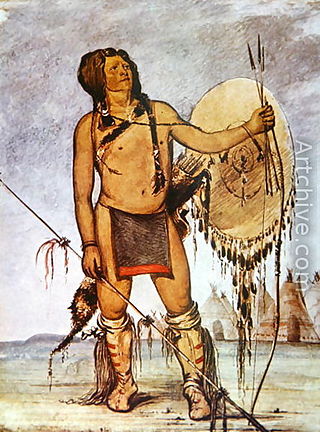
Comanche history – in the 18th and 19th centuries the Comanche became the dominant tribe on the southern Great Plains. The Comanche are often characterized as "Lords of the Plains." They presided over a large area called Comancheria which they shared with allied tribes, the Kiowa, Kiowa-Apache, Wichita, and after 1840 the southern Cheyenne and Arapaho. Comanche power and their substantial wealth depended on horses, trading, and raiding. Adroit diplomacy was also a factor in maintaining their dominance and fending off enemies for more than a century. They subsisted on the bison herds of the Plains which they hunted for food and skins.

Satank was a prestigious Kiowa warrior and medicine man. He was born about 1800, probably in Kansas, and killed June 8, 1871. An able warrior, he became part of the Koitsenko, the society of the bravest Kiowa warriors. He led many raids against the Cheyennes, the Sacs, and the Foxes. As the white settlers' importance increased, he raided settlements, wagon trains, and even army outposts.
The Comancheros were a group of 18th- and 19th-century traders based in northern and central New Mexico. They made their living by trading with the nomadic Great Plains Indian tribes in northeastern New Mexico, West Texas, and other parts of the southern plains of North America. The name "Comancheros" comes from the Comanche tribe, in whose territory they traded. They traded manufactured goods, flour, tobacco, and bread for hides, livestock and slaves from the Comanche. As the Comancheros did not have regular access to weapons and gunpowder, there is disagreement about how much they traded these with the Comanche.
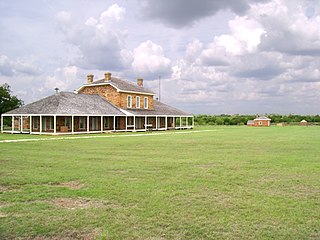
Fort Richardson was a United States Army installation located in present-day Jacksboro, Texas. Named in honor of Union General Israel B. Richardson, who died in the Battle of Antietam during the American Civil War, it was active from 1867 to 1878. Today, the site, with a few surviving buildings, is called Fort Richardson State Park, Historic Site and Lost Creek Reservoir State Trailway. It was designated a National Historic Landmark in 1963 for its role in securing the state's northern frontier in the post-Civil War era.
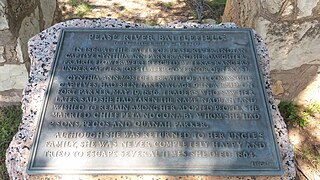
The Battle of Pease River, also known as the Pease River Massacre or the Pease River fight, occurred on December 19, 1860, near present-day Margaret, Texas in Foard County, Texas, United States. The town is located between Crowell and Vernon within sight of the Medicine Mounds just outside present-day Quanah, Texas.
The Texas–Indian wars were a series of conflicts between settlers in Texas and the Southern Plains Indians during the 19th-century. Conflict between the Plains Indians and the Spanish began before other European and Anglo-American settlers were encouraged—first by Spain and then by the newly Independent Mexican government—to colonize Texas in order to provide a protective-settlement buffer in Texas between the Plains Indians and the rest of Mexico. As a consequence, conflict between Anglo-American settlers and Plains Indians occurred during the Texas colonial period as part of Mexico. The conflicts continued after Texas secured its independence from Mexico in 1836 and did not end until 30 years after Texas became a state of the United States, when in 1875 the last free band of Plains Indians, the Comanches led by Quahadi warrior Quanah Parker, surrendered and moved to the Fort Sill reservation in Oklahoma.
Iron Jacket was a Native American War Chief and Chief of the Quahadi band of Comanche Indians.

Friendship is an incorporated town in Jackson County, Oklahoma, United States. The population was 23 as of the 2020 United States census, just down one person from the 2010 census figure of 24.
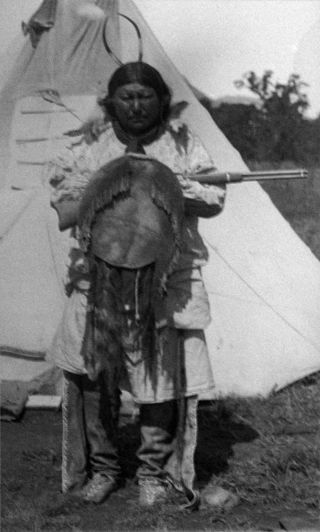
White Horse was a chief of the Kiowa. White Horse attended the council between southern plains tribes and the United States at Medicine Lodge in southern Kansas which resulted in the Medicine Lodge Treaty. Despite his attendance at the treaty signing he conducted frequent raids upon other tribes and white settlers. Follower of such elders as Guipago, Satanta and old Satank, he was often associated with Big Tree.

Horseback (1805/1810-1888) was a Nokoni Comanche chief.
Big Red Meat was a Nokoni Comanche chief and a leader of Native American resistance against White invasion during the second half of the 19th century.

Mow-way or Moway also referred to by European settlers as Shaking Hand or Hand Shaker, was the principal leader and war chief of the Kotsoteka band of the Comanche during the 1860s and 1870s, following the deaths of Kuhtsu-tiesuat in 1864 and Tasacowadi in 1872.

Ketch Ranch House or Ketch Ranch was private property located in the Wichita Mountains of Southwestern Oklahoma. During the early 1920s, the forest reserve residence was established as a working ranch and vacation home for Ada May Ketch and Frank Levant Ketch who served as mayor of Ringling, Oklahoma.